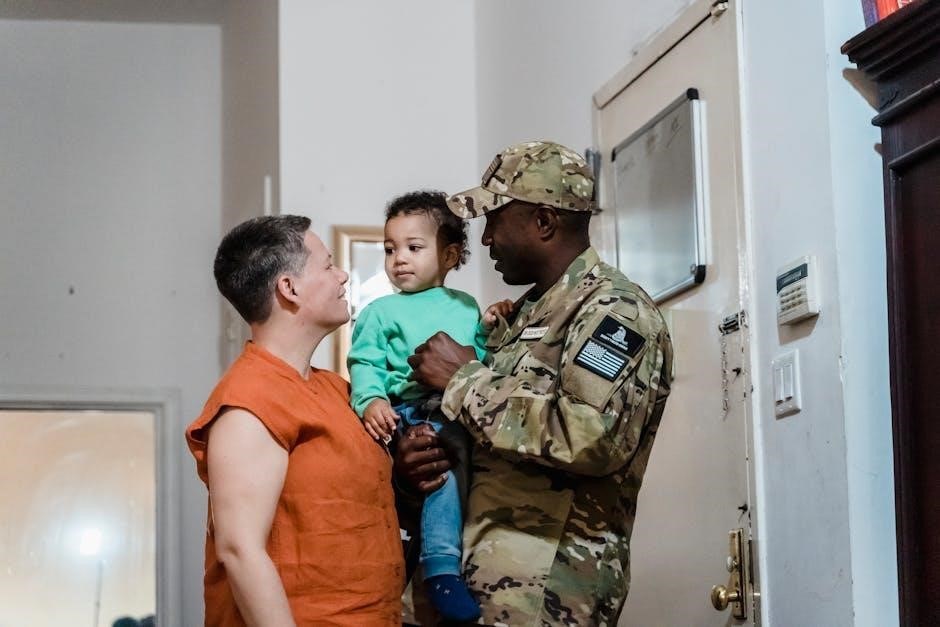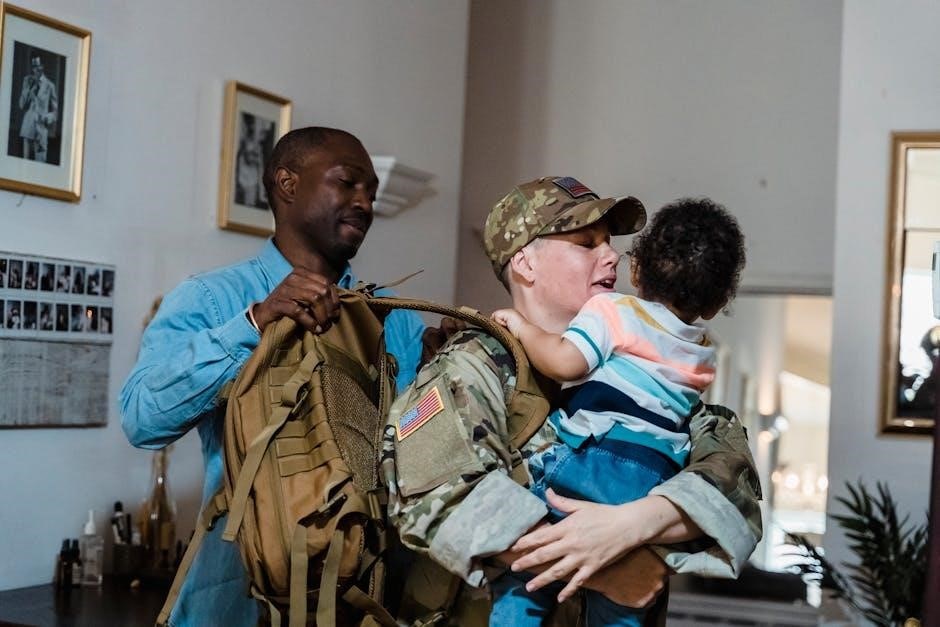Ernest Hemingway’s “Soldier’s Home” (1925) explores the post-WWI struggles of Harold Krebs‚ a soldier grappling with alienation and societal expectations upon returning to Oklahoma.
Overview of the Short Story
Ernest Hemingway’s “Soldier’s Home” is a poignant exploration of a World War I veteran’s struggle to reintegrate into civilian life. The story centers on Harold Krebs‚ who returns to his small Oklahoma hometown‚ only to find himself disconnected from his family‚ community‚ and former identity. Krebs’ experiences in the war have left him emotionally detached‚ while his hometown’s lack of interest in his stories exacerbates his alienation. The narrative delves into themes of masculinity‚ societal expectations‚ and the psychological toll of war‚ offering a stark portrayal of post-war disillusionment. Hemingway’s concise prose underscores the tension between Krebs’ inner turmoil and the superficiality of civilian life.
Historical Context of Post-WWI America
Following World War I‚ America experienced a period of social and economic transformation. The war’s end in 1918 brought a sense of relief but also widespread disillusionment. Soldiers returning home faced unemployment‚ inflation‚ and a society grappling with shifting values. The Roaring Twenties marked a cultural shift‚ yet many veterans struggled to reconcile their wartime experiences with civilian life. The public’s initial enthusiasm for soldiers faded‚ leaving many feeling disconnected and misunderstood. This backdrop of societal indifference and economic instability is central to “Soldier’s Home‚” as Harold Krebs’ struggles reflect the broader challenges faced by veterans in post-war America.
Ernest Hemingway’s Style and Themes
Hemingway’s ‘Soldier’s Home’ exemplifies his distinctive literary style‚ characterized by simplicity‚ clarity‚ and emotional restraint; Through concise prose‚ he conveys the inner turmoil of Harold Krebs‚ a soldier grappling with post-war alienation. Hemingway’s ‘iceberg theory’ is evident‚ as much of the narrative’s depth lies beneath the surface. Themes of masculinity‚ identity‚ and disillusionment are central‚ reflecting the struggles of veterans adjusting to civilian life. The story’s detached tone underscores Krebs’ emotional isolation‚ highlighting the broader societal challenges of the time. Hemingway’s approach creates a poignant exploration of the human condition‚ resonating with readers through its understated yet powerful narrative.

Plot Summary

Harold Krebs returns home after WWI‚ facing indifference and disconnection. His war stories lose appeal‚ and he struggles with civilian life‚ leading to alienation and internal conflict.
Harold Krebs’ Return Home

Harold Krebs returns to Oklahoma after World War I‚ feeling disconnected from his former life. His hometown‚ once familiar‚ now seems distant and uninterested in his war experiences. Krebs struggles with the emotional detachment and alienation that follow his return. His family‚ particularly his mother‚ expects him to resume his pre-war life‚ but Krebs finds it impossible to reconcile his past with the present. The lack of understanding from his community exacerbates his isolation‚ highlighting the broader societal challenges faced by returning soldiers. Krebs’ journey reflects the difficulty of reintegrating into civilian life after the trauma of war.
Struggles with Civilian Life

Harold Krebs faces immense difficulty adjusting to civilian life after World War I. The monotony of daily routines and societal expectations clash with his wartime experiences‚ leaving him emotionally detached. People in his hometown show little interest in his stories‚ fostering a sense of alienation. Krebs struggles with the pressure to conform to traditional roles‚ such as finding a job or marrying‚ which further frustrates him. His inability to connect with others‚ including romantic interests‚ highlights the emotional scars of war. The disconnect between his past and present creates a sense of purposelessness‚ underscoring the broader challenges of post-war reintegration.
Disconnection from Family and Community
Harold Krebs experiences profound disconnection from his family and community upon returning home. His parents‚ though loving‚ struggle to understand his wartime experiences‚ creating emotional distance. Krebs’ mother urges him to settle down‚ but her expectations clash with his inner turmoil. The community‚ indifferent to his stories‚ fails to acknowledge his sacrifices‚ deepening his isolation. Krebs feels like an outsider‚ unable to relate to the superficial conversations and routines of civilian life. This disconnection highlights the generational and societal gap‚ as well as the emotional scars of war‚ leaving Krebs alienated and withdrawn from those closest to him.
Themes in “Soldier’s Home”
The story explores themes of masculinity‚ alienation‚ and disillusionment‚ reflecting Krebs’ struggle to reconcile his wartime experiences with societal expectations and the indifference of his community.
Masculinity and Identity Crisis
In “Soldier’s Home‚” Harold Krebs embodies a post-WWI identity crisis‚ struggling to reconcile his wartime experiences with societal expectations of masculinity. Hemingway portrays Krebs as disconnected from traditional masculine roles‚ unable to embrace the narrow definitions of heroism and manhood upheld by his community. His reluctance to share war stories reflects a deeper alienation from the societal norms that once defined him. The pressure to conform to these ideals exacerbates Krebs’ internal conflict‚ leaving him isolated and uncertain about his place in a world that no longer values his experiences. This tension underscores the broader disillusionment of returning soldiers in the 1920s.
Alienation and Isolation
Harold Krebs’ return home is marked by profound alienation and isolation‚ as he struggles to reconnect with his family and community. His reluctance to share war stories highlights a disconnect between his experiences and the indifference of those around him. Krebs feels estranged from the familiar routines of civilian life‚ unable to find meaning in the mundane. His mother’s expectations and the town’s apathy exacerbate his sense of isolation‚ leaving him disconnected from the world he once knew. This alienation reflects the broader post-WWI disillusionment‚ as soldiers like Krebs grappled with the loss of purpose and identity in a society that no longer understood their sacrifices.
Disillusionment with Society
Krebs’ disillusionment with society stems from the stark contrast between the glory promised by wartime rhetoric and the harsh reality of civilian life. Upon returning‚ he finds his community indifferent to his experiences‚ as people have already moved on from the war. The societal expectation to seamlessly reintegrate into normal life clashes with his internal turmoil‚ leaving him disenchanted. Krebs’ struggle reflects the broader post-WWI disillusionment‚ as soldiers faced a society that no longer valued their sacrifices or understood their emotional scars. This disconnect highlights the fractured relationship between soldiers and the society they fought to protect.

Character Analysis
Harold Krebs’ internal conflict and identity crisis drive the narrative‚ reflecting his struggle to reconcile war experiences with civilian life and societal expectations.
Harold Krebs: The Protagonist
Harold Krebs‚ the protagonist of “Soldier’s Home‚” is a World War I veteran struggling to reintegrate into civilian life in Oklahoma. His experiences in the war have left him emotionally detached and disconnected from his family and community. Krebs grapples with societal expectations of masculinity and heroism‚ feeling unable to share his true wartime experiences. His internal conflict reflects the broader alienation of soldiers returning home‚ as he seeks to reconcile his past with the present. Through Krebs‚ Hemingway portrays the psychological toll of war and the challenges of readjusting to a society that no longer understands him.

Krebs’ Family Dynamics
Harold Krebs’ family dynamics are marked by tension and misunderstanding. His mother‚ eager for him to settle into civilian life‚ pressures him to find a wife and stable job‚ reflecting societal expectations of masculinity. Krebs‚ however‚ feels disconnected from these norms‚ leading to emotional distance. His father‚ though supportive‚ struggles to relate to his son’s experiences‚ further isolating Krebs. The family’s inability to understand his wartime struggles exacerbates his alienation‚ highlighting the generational and cultural gap between Krebs and his family. This dynamic underscores the broader theme of soldiers’ difficulties in reconnecting with their pre-war lives and relationships.
The Role of the Community
The community in “Soldier’s Home” plays a significant role in Krebs’ alienation. Upon his return‚ the townspeople initially celebrate his service but quickly lose interest in his war stories‚ preferring tales from soldiers who never fought. This indifference isolates Krebs‚ as he struggles to connect with a society that values superficial narratives over genuine experiences. The community’s lack of understanding and empathy exacerbates his feelings of disconnection‚ highlighting the broader societal failure to support returning soldiers. This dynamic underscores the tension between individual trauma and collective indifference‚ a recurring theme in post-war literature.

Literary Devices
Hemingway employs understatement and sparse dialogue to reflect Krebs’ emotional detachment. The narrative structure emphasizes alienation‚ using simplicity to convey deep psychological complexity and societal irony.
Use of Symbolism
In “Soldier’s Home‚” Ernest Hemingway employs symbolism to convey the emotional and psychological struggles of Harold Krebs. The small Oklahoma town symbolizes confinement and suffocation‚ reflecting Krebs’ alienation. His uniform‚ initially a symbol of pride‚ becomes a relic of a past life‚ highlighting his disconnection from civilian identity. The war itself serves as a symbol of lost innocence and unspoken trauma. Hemingway’s sparse prose underscores the emotional detachment‚ while the setting mirrors Krebs’ internal isolation. These symbols collectively emphasize themes of identity crisis and societal disconnection‚ offering a profound commentary on post-war disillusionment.
Narrative Structure and Tone
Hemingway’s “Soldier’s Home” features a concise‚ linear narrative structure that mirrors Harold Krebs’ emotional detachment. The story unfolds through sparse‚ direct prose‚ reflecting Krebs’ inward struggles and societal indifference. Hemingway’s signature iceberg technique is evident‚ as much of Krebs’ trauma remains unspoken‚ submerged beneath the surface. The tone is introspective and somber‚ capturing the alienation and disillusionment of a soldier returning to a world uninterested in his experiences. The narrative’s slow pacing and lack of dramatic resolution emphasize Krebs’ emotional paralysis‚ while the third-person perspective provides a detached yet intimate view of his isolation and internal conflict.
Historical and Cultural Significance
“Soldier’s Home” captures the post-WWI disillusionment of soldiers‚ reflecting the societal shift in 1920s America and the struggle to reintegrate into civilian life after combat.
Impact of WWI on Soldiers
World War I profoundly affected soldiers‚ leaving deep psychological scars and a sense of alienation. Many‚ like Harold Krebs‚ struggled to reconnect with civilian life‚ feeling disconnected from their communities. The war’s brutality and the subsequent societal indifference exacerbated their emotional detachment. Soldiers often found it difficult to articulate their experiences‚ leading to further isolation. The loss of purpose and the clash with changing social norms post-war intensified their disillusionment. This generational trauma resonated deeply‚ as soldiers grappled with the gap between their wartime realities and the expectations of a society that had moved on without them.
Changing Social Norms in the 1920s
The 1920s marked a period of significant social transformation in America‚ with shifting cultural values and norms. The post-WWI era saw a rise in modernity‚ with women gaining more independence and societal expectations evolving. Soldiers returning home‚ like Harold Krebs‚ found it challenging to adapt to these changes. The focus on progress and new freedoms contrasted sharply with the stark realities of war‚ creating a disconnect for veterans. The decade’s emphasis on individualism and self-reinvention further alienated soldiers‚ who struggled to reconcile their wartime experiences with the rapidly changing world around them.
Reception and Criticism
“Soldier’s Home” received mixed reviews upon release‚ with critics praising its raw realism but finding its tone stark. Modern analysis highlights its exploration of alienation and societal disconnect.
Initial Reception of the Story
When “Soldier’s Home” was first published in 1925‚ it received mixed reviews. Critics praised Hemingway’s bold‚ concise style but found the story’s stark realism and themes of alienation unsettling. The narrative’s focus on Krebs’ emotional detachment and societal disconnection resonated with some readers‚ while others deemed it too bleak. The story’s exploration of masculinity and disillusionment struck a chord amid post-WWI America’s shifting values. Despite initial controversy‚ it gained recognition for its unflinching portrayal of a soldier’s struggle to reintegrate into civilian life‚ marking Hemingway as a rising literary voice. Its raw honesty set it apart from more romanticized war narratives.

Modern Interpretations and Analysis
Modern scholars interpret “Soldier’s Home” as a profound exploration of post-war trauma‚ masculinity‚ and societal expectations. Analysts highlight Hemingway’s use of subtlety and understatement to convey Krebs’ emotional numbness and alienation. The story is seen as a critique of romanticized war narratives‚ offering a raw‚ unfiltered portrayal of a soldier’s struggle to reintegrate. Contemporary readings often focus on themes of identity crisis‚ psychological scarring‚ and the disconnect between individual experience and societal norms. The narrative’s sparse prose is celebrated for its ability to evoke deep emotional resonance‚ making it a timeless study of war’s aftermath and human disconnection.
“Soldier’s Home” remains a poignant exploration of post-war alienation‚ offering timeless insights into the struggles of returning soldiers and societal expectations‚ resonating deeply today.
Legacy of “Soldier’s Home”

Ernest Hemingway’s “Soldier’s Home” remains a profound exploration of post-WWI disillusionment‚ resonating with its vivid portrayal of alienation and societal disconnect. The story’s legacy lies in its unflinching depiction of a soldier’s struggle to reintegrate into civilian life‚ capturing the emotional toll of war. Its themes of masculinity‚ identity‚ and societal expectations continue to influence literary discussions. Hemingway’s concise‚ direct style amplifies the narrative’s emotional weight‚ making it a cornerstone of 20th-century literature. The story’s relevance endures‚ offering insights into the universal challenges of veterans adapting to life after conflict‚ ensuring its lasting impact on contemporary discourse.
Relevance in Contemporary Discussions
Ernest Hemingway’s “Soldier’s Home” remains a poignant reflection of the challenges veterans face upon returning to civilian life‚ resonating deeply in modern discussions about mental health and societal reintegration. The story’s themes of alienation‚ identity crisis‚ and disillusionment with societal expectations continue to mirror contemporary issues faced by soldiers transitioning from combat to civilian life. Its exploration of masculinity and the emotional toll of war offers timeless insights‚ making it a valuable text for understanding the universal struggles of veterans across generations. The narrative’s relevance endures‚ providing a historical lens through which to examine ongoing conversations about veterans’ mental health and societal support systems.
